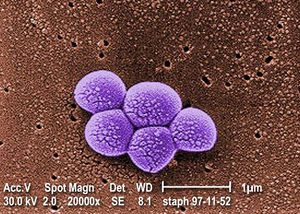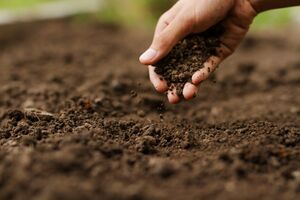Microbes in Agricultural Soil: Difference between revisions
No edit summary |
No edit summary |
||
| Line 2: | Line 2: | ||
[[Image:Mrsa_magn_lg.jpg|thumb|300px|right|Magnified 20,000X, this colorized scanning electron micrograph (SEM) depicts a grouping of methicillin resistant <i>Staphylococcus aureus</i> (MRSA) bacteria. See PHIL 617 for a black and white view of this image. Phoro credit: [http://www.cdc.gov/ CDC.]]] | [[Image:Mrsa_magn_lg.jpg|thumb|300px|right|Magnified 20,000X, this colorized scanning electron micrograph (SEM) depicts a grouping of methicillin resistant <i>Staphylococcus aureus</i> (MRSA) bacteria. See PHIL 617 for a black and white view of this image. Phoro credit: [http://www.cdc.gov/ CDC.]]] | ||
[[Image:dreamstime_l_162138825-scaled.jpeg|thumb|300px|right|Magnified 20,000X, this colorized scanning electron micrograph (SEM) depicts a grouping of methicillin resistant <i>Staphylococcus aureus</i> (MRSA) bacteria. See PHIL 617 for a black and white view of this image. Phoro credit: [http://www.cdc.gov/ CDC.]]] | [[Image:dreamstime_l_162138825-scaled.jpeg|thumb|300px|right|Magnified 20,000X, this colorized scanning electron micrograph (SEM) depicts a grouping of methicillin resistant <i>Staphylococcus aureus</i> (MRSA) bacteria SOIL. See PHIL 617 for a black and white view of this image. Phoro credit: [http://www.cdc.gov/ CDC.]]] | ||
<b>By [Author Name]<br> | <b>By [Author Name]<br> | ||
Revision as of 18:25, 4 April 2024
Section


By [Author Name]
At right is a sample image insertion. It works for any image uploaded anywhere to MicrobeWiki.
The insertion code consists of:
Double brackets: [[
Filename: PHIL_1181_lores.jpg
Thumbnail status: |thumb|
Pixel size: |300px|
Placement on page: |right|
Legend/credit: Magnified 20,000X, this colorized scanning electron micrograph (SEM) depicts a grouping of methicillin resistant Staphylococcus aureus (MRSA) bacteria. Photo credit: CDC. Every image requires a link to the source.
Closed double brackets: ]]
Other examples:
Bold
Italic
Subscript: H2O
Superscript: Fe3+
Sample citations: [1]
[2]
A citation code consists of a hyperlinked reference within "ref" begin and end codes.
To repeat the citation for other statements, the reference needs to have a names: "<ref name=aa>"
The repeated citation works like this, with a forward slash.[1]
Introduction
Many agroecologists have said that in order to feed an ecosystem you need to feed the soil. Under this logic, innovations with microorganisms, something already present in the soil, can aid future research towards more sustainable, less extractive, agriculture. Soil microbes serve a variety of functions including pest and disease control, increasing both plant growth and quality, and biodegradation of organic matter and other pollutants [1]. In addition to the number of activities that promote-plant health, microbes are also directly beneficial to plant health [2]. Forming symbiotic relationships with plants, rhizobia enables plants to obtain oxygen while phosphate-stabilizing bacteria enable plants to obtain phosphate [2]. Microbes not only help ensure the healthy growth of plants, but they are also useful for regenerating tainted soils. Microorganisms are metabolic capabilities that can serve a useful bioremediation tool for soil contaminated with heavy metal or organic pollutants [1].
Every point of information REQUIRES CITATION using the citation tool shown above.
Section 2
Include some current research, with at least one figure showing data.
Section 3
Include some current research, with at least one figure showing data.
Section 4
Conclusion
References
Authored for BIOL 238 Microbiology, taught by Joan Slonczewski,at Kenyon College,2024
